Cycads of South Africa
Moderator: Klipspringer
- Lisbeth
- Site Admin
- Posts: 67667
- Joined: Sat May 19, 2012 12:31 pm
- Country: Switzerland
- Location: Lugano
- Contact:
Re: Cycads of South Africa
Very pretty! What a pity that the family of the cycads are almost gone in the wild 
"Education is the most powerful weapon which you can use to change the world." Nelson Mandela
The desire for equality must never exceed the demands of knowledge
The desire for equality must never exceed the demands of knowledge
-
Sharifa
Re: Cycads of South Africa
E. humillis
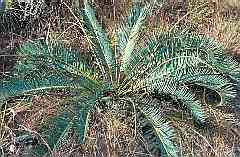
Etymology:
Latin humilis, humble or lowly, from the small stature.
Description:
Plants acaulescent; stem 0.3 m tall, 20 cm diam.
Leaves 30-50 cm long, dark green, semiglossy, slightly keeled (opposing leaflets inserted at 120-160° on rachis); rachis yellowish, straight with last third sharply recurved, slightly twisted in some leaves; petiole straight, with no prickles; leaf-base collar not present; basal leaflets not reducing to spines.
Leaflets linear, strongly discolorous, not overlapping, not lobed, insertion angle obtuse (45-80°); margins flat; upper margin entire (no teeth); lower margin entire (no teeth); median leaflets 9-13 cm long, 4-6 mm wide.
Pollen cones 1, narrowly ovoid, brown, 15-20 cm long, 4-5 cm diam.
Seed cones 1, ovoid, brown, 25-30 cm long, 8-10 cm diam.
Seeds ovoid, 25-30 mm long, 20-25 mm wide, sarcotesta yellow.
Distinguishing features:
A dwarf species with very little clear trunk and short, keeled, twisted and recurved leaves with entire leaflets. Other dwarf species with short leaves have straight, erect, more or less flat leaves. E. humilis is though to be most closely related to the much larger and longer-leaved arborescent species E. lanatus and E. laevifolius.
Distribution and habitat:
Eastern Transvaal Province, South Africa, in grassland on slopes on sandy soils over sandstones.
Conservation:
1997 IUCN Red List of Threatened Plants category V.
Reference: The Cycad Pages

Etymology:
Latin humilis, humble or lowly, from the small stature.
Description:
Plants acaulescent; stem 0.3 m tall, 20 cm diam.
Leaves 30-50 cm long, dark green, semiglossy, slightly keeled (opposing leaflets inserted at 120-160° on rachis); rachis yellowish, straight with last third sharply recurved, slightly twisted in some leaves; petiole straight, with no prickles; leaf-base collar not present; basal leaflets not reducing to spines.
Leaflets linear, strongly discolorous, not overlapping, not lobed, insertion angle obtuse (45-80°); margins flat; upper margin entire (no teeth); lower margin entire (no teeth); median leaflets 9-13 cm long, 4-6 mm wide.
Pollen cones 1, narrowly ovoid, brown, 15-20 cm long, 4-5 cm diam.
Seed cones 1, ovoid, brown, 25-30 cm long, 8-10 cm diam.
Seeds ovoid, 25-30 mm long, 20-25 mm wide, sarcotesta yellow.
Distinguishing features:
A dwarf species with very little clear trunk and short, keeled, twisted and recurved leaves with entire leaflets. Other dwarf species with short leaves have straight, erect, more or less flat leaves. E. humilis is though to be most closely related to the much larger and longer-leaved arborescent species E. lanatus and E. laevifolius.
Distribution and habitat:
Eastern Transvaal Province, South Africa, in grassland on slopes on sandy soils over sandstones.
Conservation:
1997 IUCN Red List of Threatened Plants category V.
Reference: The Cycad Pages
-
Sharifa
Re: Cycads of South Africa
E. inopinus
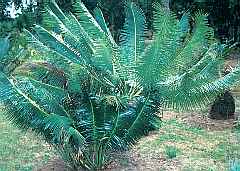
Description:
Plants arborescent; stem 3 m tall, 15-25 cm diam.
Leaves 100-150 cm long, blue or silver, semiglossy, flat (not keeled) in section (opposing leaflets inserted at 180° on rachis); rachis yellowish, straight, stiff, slightly twisted in some leaves; petiole straight, with no prickles; leaf-base collar prominent; basal leaflets not reducing to spines.
Leaflets lanceolate, concolorous, not overlapping, not lobed, insertion angle horizontal; margins flat; upper margin entire (no teeth); lower margin entire (no teeth); median leaflets 14-20 cm long, 8-10 mm wide.
Pollen cones 1-3, narrowly ovoid, green, 18-25 cm long, 6-8 cm diam.
Seed cones 1-2, ovoid, green, 30-35 cm long, 15-20 cm diam.
Seeds ovoid or oblong, 20-25 mm long, 15-20 mm wide, sarcotesta orange.
Distinguishing features:
A taxonomically isolated species that is not readily confused with any other. The spreading crown of flat, bluish leaves with well-spaced, entire, broad-based leaflets that droop away from the rachis are immediately distinctive.
Distribution and habitat:
Eastern Transvaal Province, South Africa, in skeletal or no soil, on steep to precipitous slopes in gorges on dolomites.
Historical notes:
Although first discovered in 1955, this species was not described until 1964 by South African botanist R. Allen Dyer.
Conservation:
1997 IUCN Red List of Threatened Plants category E.
Reference: The Cycad Pages

Description:
Plants arborescent; stem 3 m tall, 15-25 cm diam.
Leaves 100-150 cm long, blue or silver, semiglossy, flat (not keeled) in section (opposing leaflets inserted at 180° on rachis); rachis yellowish, straight, stiff, slightly twisted in some leaves; petiole straight, with no prickles; leaf-base collar prominent; basal leaflets not reducing to spines.
Leaflets lanceolate, concolorous, not overlapping, not lobed, insertion angle horizontal; margins flat; upper margin entire (no teeth); lower margin entire (no teeth); median leaflets 14-20 cm long, 8-10 mm wide.
Pollen cones 1-3, narrowly ovoid, green, 18-25 cm long, 6-8 cm diam.
Seed cones 1-2, ovoid, green, 30-35 cm long, 15-20 cm diam.
Seeds ovoid or oblong, 20-25 mm long, 15-20 mm wide, sarcotesta orange.
Distinguishing features:
A taxonomically isolated species that is not readily confused with any other. The spreading crown of flat, bluish leaves with well-spaced, entire, broad-based leaflets that droop away from the rachis are immediately distinctive.
Distribution and habitat:
Eastern Transvaal Province, South Africa, in skeletal or no soil, on steep to precipitous slopes in gorges on dolomites.
Historical notes:
Although first discovered in 1955, this species was not described until 1964 by South African botanist R. Allen Dyer.
Conservation:
1997 IUCN Red List of Threatened Plants category E.
Reference: The Cycad Pages
-
Sharifa
Re: Cycads of South Africa
E. laevifolius
Etymology:
Latin laevis, smooth and folius, leaf, in reference to the lack of tomentum in comparison to the related E. lanatus.

Description:
Plants arborescent; stem 3 m tall, 25 cm diam.
Leaves 150 cm long, blue or silver to blue green, dull, moderately keeled or slightly keeled (opposing leaflets inserted at 90-150° on rachis); rachis yellowish, straight, stiff, not spirally twisted; petiole straight, with no prickles; leaf-base collar not present; basal leaflets not reducing to spines.
Leaflets linear, weakly discolorous, not overlapping, not lobed, insertion angle obtuse (45-80°); margins flat; upper margin entire (no teeth); lower margin entire (no teeth); median leaflets 12-15 cm long, 5-7 mm wide.
Pollen cones 1-6, ovoid, yellow, 30-40 cm long, 10 cm diam.
Seed cones 1-5, ovoid, yellow, 20-30 cm long, 15-20 cm diam.
Seeds ovoid, 25-27 mm long, 20-23 mm wide, sarcotesta yellow.
Historical notes:
Described in 1926 by English botanists Otto Stapf and Joseph Burtt Davy.
Distinguishing features:
The robust stems and relatively narrow entire leaflets emerging with a bluish tint and turning dark green with age place this species nearest to E. lanatus and E. friderici-guilielmi. It is distinguished from both by the straight and flat leaves and the almost smooth crowns, leaf-bases and cones.
Distribution and habitat:
South-eastern Transvaal Province and north-eastern Natal, South Africa, and adjacent parts of Swaziland, in grassland or low shrubs on steep rocky slopes.
Conservation:
1997 IUCN Red List of Threatened Plants category E.
Reference:The Cycad Pages
Etymology:
Latin laevis, smooth and folius, leaf, in reference to the lack of tomentum in comparison to the related E. lanatus.

Description:
Plants arborescent; stem 3 m tall, 25 cm diam.
Leaves 150 cm long, blue or silver to blue green, dull, moderately keeled or slightly keeled (opposing leaflets inserted at 90-150° on rachis); rachis yellowish, straight, stiff, not spirally twisted; petiole straight, with no prickles; leaf-base collar not present; basal leaflets not reducing to spines.
Leaflets linear, weakly discolorous, not overlapping, not lobed, insertion angle obtuse (45-80°); margins flat; upper margin entire (no teeth); lower margin entire (no teeth); median leaflets 12-15 cm long, 5-7 mm wide.
Pollen cones 1-6, ovoid, yellow, 30-40 cm long, 10 cm diam.
Seed cones 1-5, ovoid, yellow, 20-30 cm long, 15-20 cm diam.
Seeds ovoid, 25-27 mm long, 20-23 mm wide, sarcotesta yellow.
Historical notes:
Described in 1926 by English botanists Otto Stapf and Joseph Burtt Davy.
Distinguishing features:
The robust stems and relatively narrow entire leaflets emerging with a bluish tint and turning dark green with age place this species nearest to E. lanatus and E. friderici-guilielmi. It is distinguished from both by the straight and flat leaves and the almost smooth crowns, leaf-bases and cones.
Distribution and habitat:
South-eastern Transvaal Province and north-eastern Natal, South Africa, and adjacent parts of Swaziland, in grassland or low shrubs on steep rocky slopes.
Conservation:
1997 IUCN Red List of Threatened Plants category E.
Reference:The Cycad Pages
-
Sharifa
Re: Cycads of South Africa
E. lanatus
Etymology:
Latin lanatus, woolly
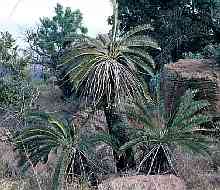
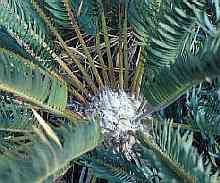
Description:
Plants arborescent; stem 1-1.5 m tall, 25-30 cm diam.
Leaves 100 cm long, blue green, dull, strongly keeled (opposing leaflets inserted at 40-80° on rachis); rachis yellowish, straight with last third sharply recurved, not spirally twisted; petiole straight, with no prickles; leaf-base collar not present; basal leaflets reducing to spines.
Leaflets linear, weakly discolorous, overlapping downwards or not overlapping, not lobed, insertion angle horizontal; margins flat; upper margin entire (no teeth); lower margin entire (no teeth); median leaflets 10-14 cm long, 6-8 mm wide.
Pollen cones 1-4, narrowly ovoid, red, 25-30 cm long, 5-6 cm diam.
Seed cones 1-4, ovoid, yellow, 25-30 cm long, 12-15 cm diam.
Seeds ovoid or oblong, 25-30 mm long, 20-25 mm wide, sarcotesta yellow.
Distinguishing features:
The robust stems and relatively narrow entire leaflets emerging with a bluish tint and turning dark green with age place this species nearest to E. lanatus and E. friderici-guilielmi. It is distinguished from E. laevifolius by the keeled leaves that are distinctly recurved at the tips and the densely woolly crowns, leaf-bases and cones. E. friderici-guilielmi has straight leaves and more numerous cones.
Distribution and habitat:
Eastern Transvaal Province, South Africa, in grassland or low shrubs on steep rocky slopes.
Historical notes:
Described in 1926 by English botanists Otto Stapf and Joseph Burtt Davy.
Conservation:
1997 IUCN Red List of Threatened Plants category R.
Reference: The Cycad Pages
Etymology:
Latin lanatus, woolly


Description:
Plants arborescent; stem 1-1.5 m tall, 25-30 cm diam.
Leaves 100 cm long, blue green, dull, strongly keeled (opposing leaflets inserted at 40-80° on rachis); rachis yellowish, straight with last third sharply recurved, not spirally twisted; petiole straight, with no prickles; leaf-base collar not present; basal leaflets reducing to spines.
Leaflets linear, weakly discolorous, overlapping downwards or not overlapping, not lobed, insertion angle horizontal; margins flat; upper margin entire (no teeth); lower margin entire (no teeth); median leaflets 10-14 cm long, 6-8 mm wide.
Pollen cones 1-4, narrowly ovoid, red, 25-30 cm long, 5-6 cm diam.
Seed cones 1-4, ovoid, yellow, 25-30 cm long, 12-15 cm diam.
Seeds ovoid or oblong, 25-30 mm long, 20-25 mm wide, sarcotesta yellow.
Distinguishing features:
The robust stems and relatively narrow entire leaflets emerging with a bluish tint and turning dark green with age place this species nearest to E. lanatus and E. friderici-guilielmi. It is distinguished from E. laevifolius by the keeled leaves that are distinctly recurved at the tips and the densely woolly crowns, leaf-bases and cones. E. friderici-guilielmi has straight leaves and more numerous cones.
Distribution and habitat:
Eastern Transvaal Province, South Africa, in grassland or low shrubs on steep rocky slopes.
Historical notes:
Described in 1926 by English botanists Otto Stapf and Joseph Burtt Davy.
Conservation:
1997 IUCN Red List of Threatened Plants category R.
Reference: The Cycad Pages
- Lisbeth
- Site Admin
- Posts: 67667
- Joined: Sat May 19, 2012 12:31 pm
- Country: Switzerland
- Location: Lugano
- Contact:
Re: Cycads of South Africa
How many species are there? 
"Education is the most powerful weapon which you can use to change the world." Nelson Mandela
The desire for equality must never exceed the demands of knowledge
The desire for equality must never exceed the demands of knowledge
-
Sharifa
Re: Cycads of South Africa
Quite a few more to come Lisbeth 
Encephalarthos is the second largest in the cycad family, with 60 species and 37 of them occurring in the eastern part of South Africa
Agree Toko the dwarf ones are very pretty and have soft leaves.
Encephalarthos is the second largest in the cycad family, with 60 species and 37 of them occurring in the eastern part of South Africa
Agree Toko the dwarf ones are very pretty and have soft leaves.
-
Sharifa
Re: Cycads of South Africa
E. latifrons
Etymology:
Latin latus, broad and frons, a fern frond or leaf. A misnomer since it is the leaflets that are broad and not the leaves.
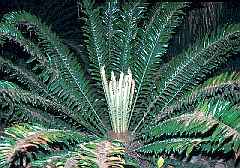
Description:
Plants arborescent; stem 3 m tall, 30-35 cm diam.
Leaves 100-150 cm long, yellow green to light or bright green, highly glossy, moderately keeled (opposing leaflets inserted at 90-120° on rachis); rachis yellowish, straight with last third sharply recurved, not spirally twisted; petiole straight, with no prickles; leaf-base collar not present; basal leaflets not reducing to spines.
Leaflets ovate, strongly discolorous, overlapping upwards, with 2-3 lobes on most leaflets, insertion angle obtuse (45-80°); margins flat; upper margin entire (no teeth); lower margin entire (no teeth); median leaflets 10-15 cm long, 40-60 mm wide.
Pollen cones 1-3, ovoid, green, 30-50 cm long, 8-17 cm diam.
Seed cones 1-3, ovoid, green, 50-60 cm long, 25 cm diam.
Seeds oblong, 25-33 mm long, 16-18 mm wide, sarcotesta red.
Distinguishing features:
Distinguished by the mid to deep green glossy leaves with broad, closely crowded, overlapping leaflets with lobes on the lower margins only. It is most similar to E. arenarius, which has shorter stems and dull, slightly silver or grey leaves. Median leaflets of E. latifrons are and twisted out of the leaf plane, but separate and untwisted in E. arenarius.
Distribution and habitat:
Eastern Cape Province, South Africa, in dense shrubland on rocky ridges and slopes.
Conservation:
1997 IUCN Red List of Threatened Plants category E.
Historical notes: Described in 1838 by German botanist J.G.C. Lehmann.
Reference: The Cycad Pages
Etymology:
Latin latus, broad and frons, a fern frond or leaf. A misnomer since it is the leaflets that are broad and not the leaves.

Description:
Plants arborescent; stem 3 m tall, 30-35 cm diam.
Leaves 100-150 cm long, yellow green to light or bright green, highly glossy, moderately keeled (opposing leaflets inserted at 90-120° on rachis); rachis yellowish, straight with last third sharply recurved, not spirally twisted; petiole straight, with no prickles; leaf-base collar not present; basal leaflets not reducing to spines.
Leaflets ovate, strongly discolorous, overlapping upwards, with 2-3 lobes on most leaflets, insertion angle obtuse (45-80°); margins flat; upper margin entire (no teeth); lower margin entire (no teeth); median leaflets 10-15 cm long, 40-60 mm wide.
Pollen cones 1-3, ovoid, green, 30-50 cm long, 8-17 cm diam.
Seed cones 1-3, ovoid, green, 50-60 cm long, 25 cm diam.
Seeds oblong, 25-33 mm long, 16-18 mm wide, sarcotesta red.
Distinguishing features:
Distinguished by the mid to deep green glossy leaves with broad, closely crowded, overlapping leaflets with lobes on the lower margins only. It is most similar to E. arenarius, which has shorter stems and dull, slightly silver or grey leaves. Median leaflets of E. latifrons are and twisted out of the leaf plane, but separate and untwisted in E. arenarius.
Distribution and habitat:
Eastern Cape Province, South Africa, in dense shrubland on rocky ridges and slopes.
Conservation:
1997 IUCN Red List of Threatened Plants category E.
Historical notes: Described in 1838 by German botanist J.G.C. Lehmann.
Reference: The Cycad Pages
-
Sharifa
Re: Cycads of South Africa
E. lebomboensis
Etymology:
From the Lebombo Mountains, northern Natal Province, with the Latin termination -ensis, place of origin.
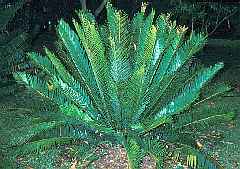
Description:
Plants arborescent; stem 4 m tall, 25-30 cm diam.
Leaves 100-150 cm long, light or bright green, highly glossy, slightly keeled (opposing leaflets inserted at 120-150° on rachis); rachis green, straight, stiff, not spirally twisted; petiole straight, with 6-12 prickles; leaf-base collar not present; basal leaflets reducing to spines.
Leaflets lanceolate, strongly discolorous, overlapping downwards, not lobed, insertion angle obtuse (45-80°); margins flat; upper margin lightly toothed (1-3 teeth), or heavily toothed (more than 3 teeth); lower margin lightly toothed (1-3 teeth), or heavily toothed (more than 3 teeth); median leaflets 12-18 cm long, 15 mm wide.
Pollen cones 1-3, narrowly ovoid, yellow, 40-45 cm long, 12-15 cm diam.
Seed cones 1-3, ovoid, yellow, 40-45 cm long, 25-30 cm diam.
Seeds oblong, 30-40 mm long, 18-22 mm wide, sarcotesta red.
Distinguishing features:
A medium growing species with bright green glossy leaves, leaflets held in a V and yellow cones, very closely allied to and long confused with E. senticosus; both of these species also allied to E. natalensis, E. altensteinii and E. woodii. E. lebomboensis is distinguished in this group by the shorter leaves with a straight rachis, the narrower, overlapping leaflets with 2-4 prickles on each margin, the basal leaflets reducing to spines, leaving no bare petiole, and the lack of woolly tomentum in the crown around newly emerging leaves. It is distinguished from E. senticosus by the narrower leaflets and incurved leaf tips, and usually solitary or paired greenish-yellow cones. Stems are also shorter. See also E. msinganus, another recently separated species distinguished by the shorter, slightly broader leaflets and verrucose cone scales.
Distribution and habitat:
South-eastern Transvaal, South Africa, a single population in the upper Pongolo River catchment near the town of Piet Retief, in grassland on steep rocky slopes.
Conservation:
1997 IUCN Red List of Threatened Plants category R.
Reference: The Cycad Pages
Etymology:
From the Lebombo Mountains, northern Natal Province, with the Latin termination -ensis, place of origin.

Description:
Plants arborescent; stem 4 m tall, 25-30 cm diam.
Leaves 100-150 cm long, light or bright green, highly glossy, slightly keeled (opposing leaflets inserted at 120-150° on rachis); rachis green, straight, stiff, not spirally twisted; petiole straight, with 6-12 prickles; leaf-base collar not present; basal leaflets reducing to spines.
Leaflets lanceolate, strongly discolorous, overlapping downwards, not lobed, insertion angle obtuse (45-80°); margins flat; upper margin lightly toothed (1-3 teeth), or heavily toothed (more than 3 teeth); lower margin lightly toothed (1-3 teeth), or heavily toothed (more than 3 teeth); median leaflets 12-18 cm long, 15 mm wide.
Pollen cones 1-3, narrowly ovoid, yellow, 40-45 cm long, 12-15 cm diam.
Seed cones 1-3, ovoid, yellow, 40-45 cm long, 25-30 cm diam.
Seeds oblong, 30-40 mm long, 18-22 mm wide, sarcotesta red.
Distinguishing features:
A medium growing species with bright green glossy leaves, leaflets held in a V and yellow cones, very closely allied to and long confused with E. senticosus; both of these species also allied to E. natalensis, E. altensteinii and E. woodii. E. lebomboensis is distinguished in this group by the shorter leaves with a straight rachis, the narrower, overlapping leaflets with 2-4 prickles on each margin, the basal leaflets reducing to spines, leaving no bare petiole, and the lack of woolly tomentum in the crown around newly emerging leaves. It is distinguished from E. senticosus by the narrower leaflets and incurved leaf tips, and usually solitary or paired greenish-yellow cones. Stems are also shorter. See also E. msinganus, another recently separated species distinguished by the shorter, slightly broader leaflets and verrucose cone scales.
Distribution and habitat:
South-eastern Transvaal, South Africa, a single population in the upper Pongolo River catchment near the town of Piet Retief, in grassland on steep rocky slopes.
Conservation:
1997 IUCN Red List of Threatened Plants category R.
Reference: The Cycad Pages


